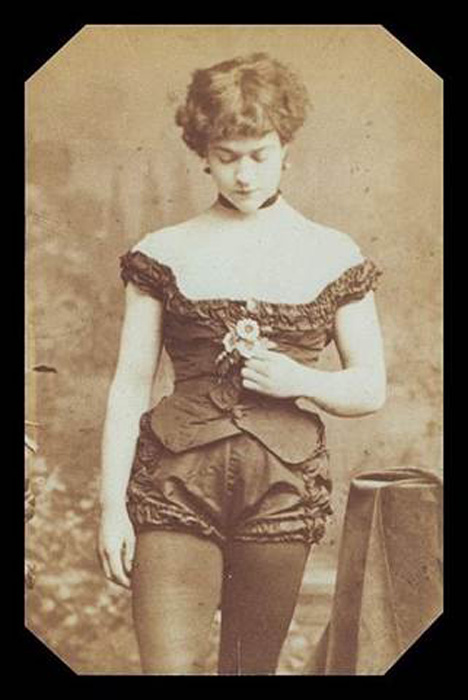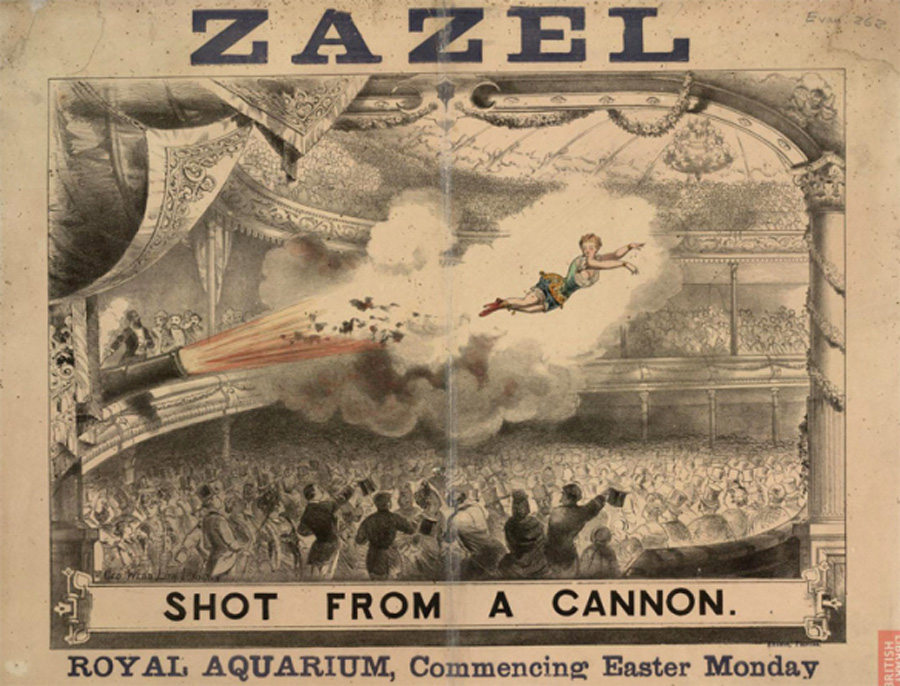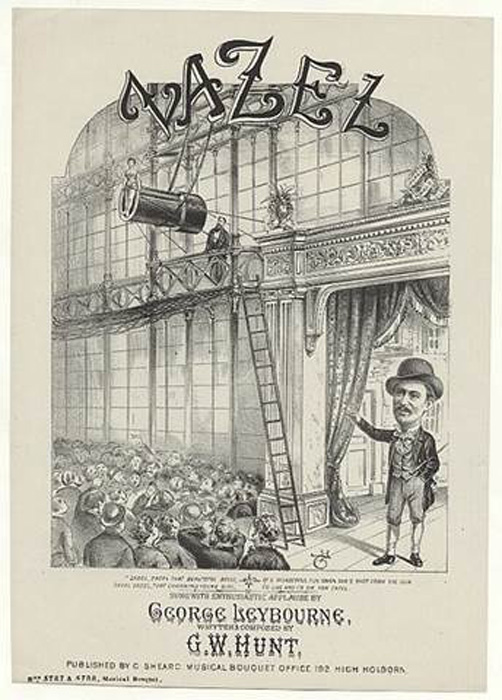The circus has long had a reputation for amazing stunts and daring feats of bravery. One of the most famous, and most dangerous is that of the human cannonball. Humans have long dreamt of flying in the blue skies, and, in a way, this gave them the opportunity.
An individual is ejected from a cannon and usually lands on an inflated bag or horizontal net placed at the point of landing, which can vary from a carefully calculated spot to a “best guess.” Often when the act is performed outdoors, landing in a body of water was preferred.
This is not a safe activity, even today. So, as you might imagine, the first person to decide this was a good idea must have been brave or foolish, indeed.
Rossa Matilda Richter
Rossa Matilda Richter, known popularly as “Zazel,” was just such a person. Right from a very early age, Rossa performed a number of aerial acts including dives and trapeze work. By the time she was 14, she was a popular name among the public, known for her beauty, physique, and compact strength.
Rossa was born to Ernst Karl Richter and Susanne Richter in 1860 in London. Her father was a talent agent who used to supply animals and performers to different circuses and productions, while her mother was a dancer in the circus.

During her childhood, she learned how to perform and, crucially, how to fall safely. At the tender age of four or five, she started her performance career as “La Petite Lulu.” She became well known for her “leap-for-life” stunt.
Zazel, The Human Cannonball
The idea of the human cannonball act was first conceived by a Canadian daredevil called William Leonard Hunt. He was popular among the people as “The Great Farini” and was also the inventor of the human cannonball device.
In 1871, he developed as well as patented the mechanism for launching the human projectile into a safety net. However, the device as he conceived it was quite dangerous as the performer had very little control over the movement and trajectile.

On the 2nd of April, 1877, Rossa Richter, debuted her spectacular aerial act at the London Aquarium where she was known as Zazel, the first human cannonball. She was subjected to the highest level of danger.
Zazel was fired from a spring-style cannon. In the cannon, rubber springs were used in order not to launch Rossa too far, in case she overshot her landing zone. She traveled over 70 feet (21 m) through the air and finally landed in a safety net, although records of the distance vary from source to source.
Despite all the odds, she had succeeded in performing the dangerous act. Her astonishing act silenced all the spectators present at the event venue, who had felt quite nervous as they waited for the torch to be lit and the young girl to fly in the air. And with good reason: she had little control over where she would land and had no option but to rely on her sheer courage to complete the performance successfully.
Shot To Fame
Her performance was stunning and mesmerizing and made her name. The audiences started calling her by different names such as “Zazel, the Champion of the World,” “Zazel, the Darling,” “Zazel, the Human Cannonball,” “Zazel, the Wonder of the World,” “Zazel, the Graceful,” and “Zazel, the Only Lady Gymnast.”
Zazel’s performance was unlike anything audiences had seen before, and she became hugely popular. Every newspaper started publishing articles and news about her astonishing acts, and their readers seemed to want to know everything they could about the daredevil.
She was so much in demand among the public that she started performing the stunt twice a day. Most of the time, she played to sell-out crowds, in different venues across western Europe. In a single performance, she was able to draw about 10,000 people.

Her muscular strength enabled her to withstand the shock effectively, while her presence of mind helped in guiding her flight, for which she never failed to get loud and never-ending applauses.
Accident And Injury
While Zazel built a reputation as a phenomenal aerial act performer, not all of her performances went smoothly. She suffered a number of injuries during the cannonball act. Her first accident occurred at the Royal Aquarium.
- “Freak Shows”: P T Barnum and the Circus of Exploitation
- Tennessee Town Hangs Murderous Mary the Elephant
She suffered another accident in 1879 at Portsmouth. In the accident at Portsmouth, the net that was used to catch her had deteriorated, and she fell through.
Luckily, she did not break any bones. However, the serious injuries caused due to the accident limited her from performing the following day. A number of newspapers at that time went on to express the outrage at the people who had risked her life in this way.
Later in 1879, during a trapeze performance at Chatham Circus in December, Zazel again fell from a height. However, fortunately, she was caught in the accident net. She was carried from the stage and kept murmuring, “I am killed.”
Luckily, she wasn’t killed but had sustained some serious injuries. The circus owner however ignored her injuries and made her reappear on stage within half an hour. She performed her remaining act with bandaged hands and was cheered by the gleeful audience.
A Great Survivor
Rossa Richter later married a press agent named George Oscar Starr. Together, they established the Starr Opera Company in 1886. In her later life, Rossa returned to the circus and leveraged her expertise in order to educate the public about safety.
As she grew older and retired, she moved back to London along with her husband. She died at Peckham’s Camberwell House hospital on the 8th of December 1937.
Top Image: Zazel, The first Human Cannonball. Source: London Stereoscopic Co. / Public Domain.
By Bipin Dimri